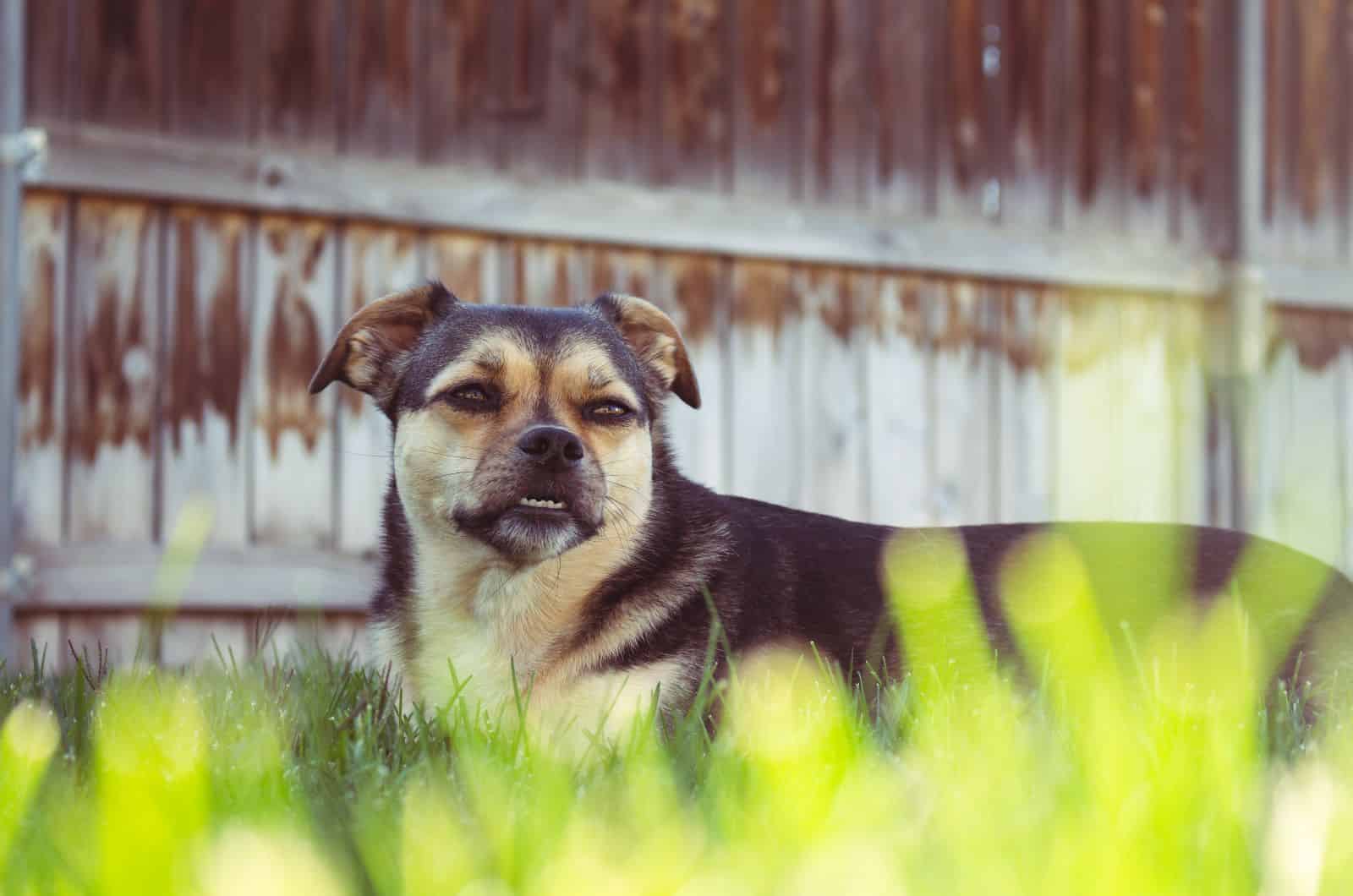The German Shepherd (also known as the GSD) and the Pug dog. Can you think of two dog breeds that are so different from each other?
Well, okay, maybe you can, as there’s such a wide variety of dogs out there! But, you have to admit, these two are really different in terms of shape, size, history, and background.
Whether you love them or not (and what’s not to love?), designer dogs are here to stay. Although they’ve technically been around for thousands of years, often created by accident, crossbreeds suddenly became popular in the 1990s after the creation of the Goldendoodle. Since that time, hundreds of new hybrids have been produced as the demand for these unusual dogs has increased. The German Shepherd Pug mix is one of these unique designer dogs, but you might not know much about it as it is so new.
We’re here to put that right!
By the time that you’ve read this article, you’ll know all about this unlikely combination, and you will have all the information you need to decide whether it’s the dog for you.
We’ll begin by looking at the two parent breeds to see what qualities they might bring to these unique designer dogs.
The German Shepherd
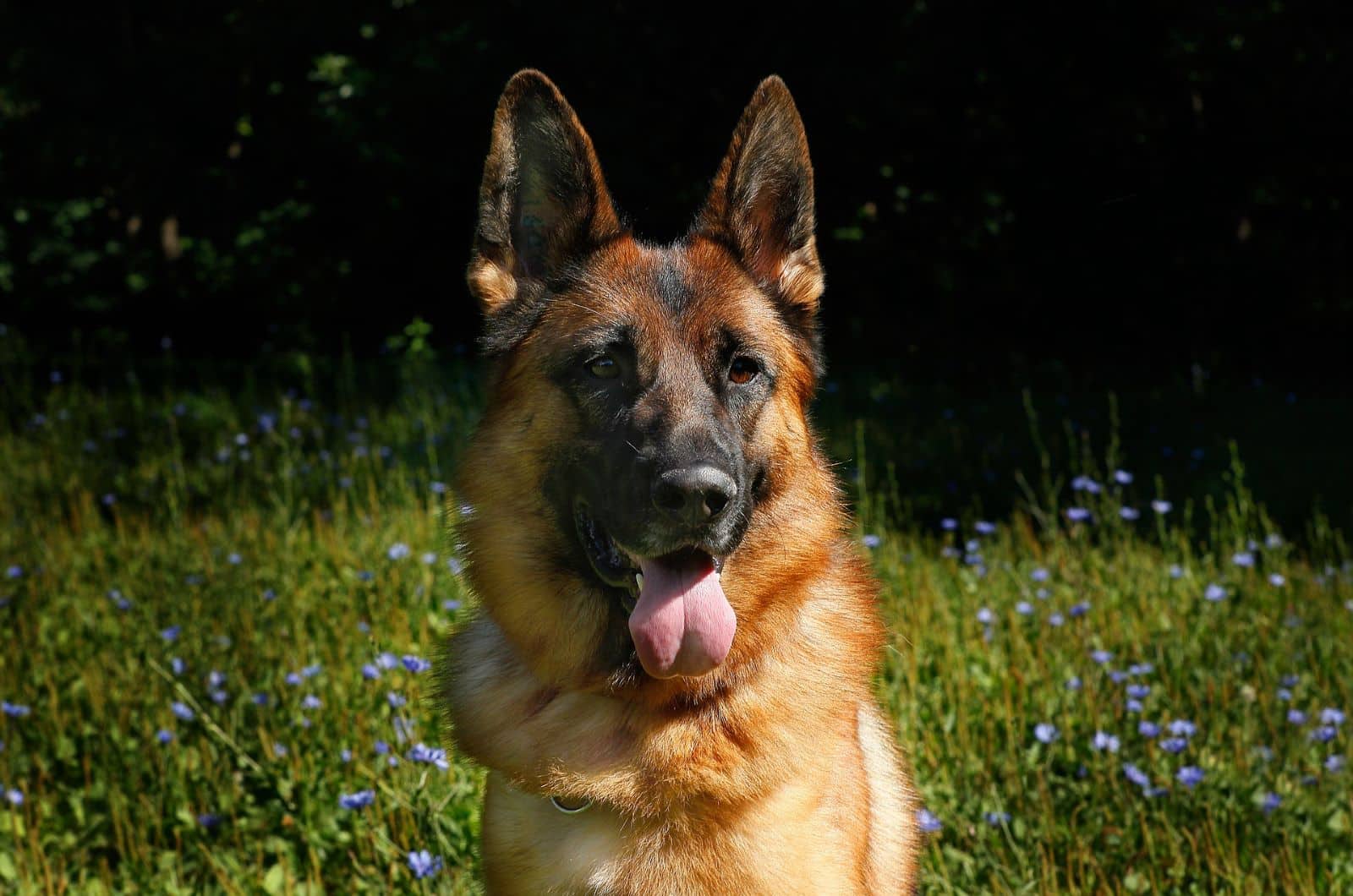
This is one beautiful-looking dog, with its proud, pointed features, erect ears, and alert expression. You can see intelligence in those soulful eyes, as well as a deep love for their owners.
They are pretty big dogs, measuring between 22 and 26 inches, and weighing between 50 and 90 pounds. Females are generally on the lower end of these scales. You can check the German Shepherd growth chart for more information.
As their name implies, they originated in Germany where they made excellent herding dogs and protectors of livestock. These noble dogs are thought to have ancestry stretching as far back as 7,000 BC! The breed we recognize today was established in 1899 by a German man by the name of Max Stephanitz, who created them by using the best of the herding breeds in rural German regions.
To this day, many dog lovers believe that Stephanitz created the perfect working dog. Although not many are used to herd sheep these days, thousands of GSDs have found roles with the police and armed services, or as guard dogs and service dogs for people with disabilities.
Despite its wolf-like appearance and admirable qualities as a working dog, the German Shepherd also makes an excellent family pet when placed with the right family.
This is a highly energetic and intelligent dog that is very affectionate with family and good with young kids. The German Shepherd does well with active families that love sporty, outdoor pursuits. You’ll need to set aside at least two hours a day to make sure she gets enough exercise, and this should include mental stimulation as well. This is a dog that thrives on being given a job to do!
Although most people imagine the GSD to have a black and tan coat, they can come in eleven official colors, according to the breed standards set by the American Kennel Club (AKC). They have a medium-length double coat that needs a quick brush every few days to keep it free from debris and tangles.
Twice a year, she’ll blow her undercoat, and you’ll need to brush her every day unless you want fur stuck all over your home and furniture!
One of the GSD’s best features is that it is easy to train. Its intelligence, coupled with a real desire to please you, makes it easy for it to learn and remember commands. And, it’ll just love to follow your orders because that’s what it was bred to do.
Now, let’s look at the other half!
The Pug Dog
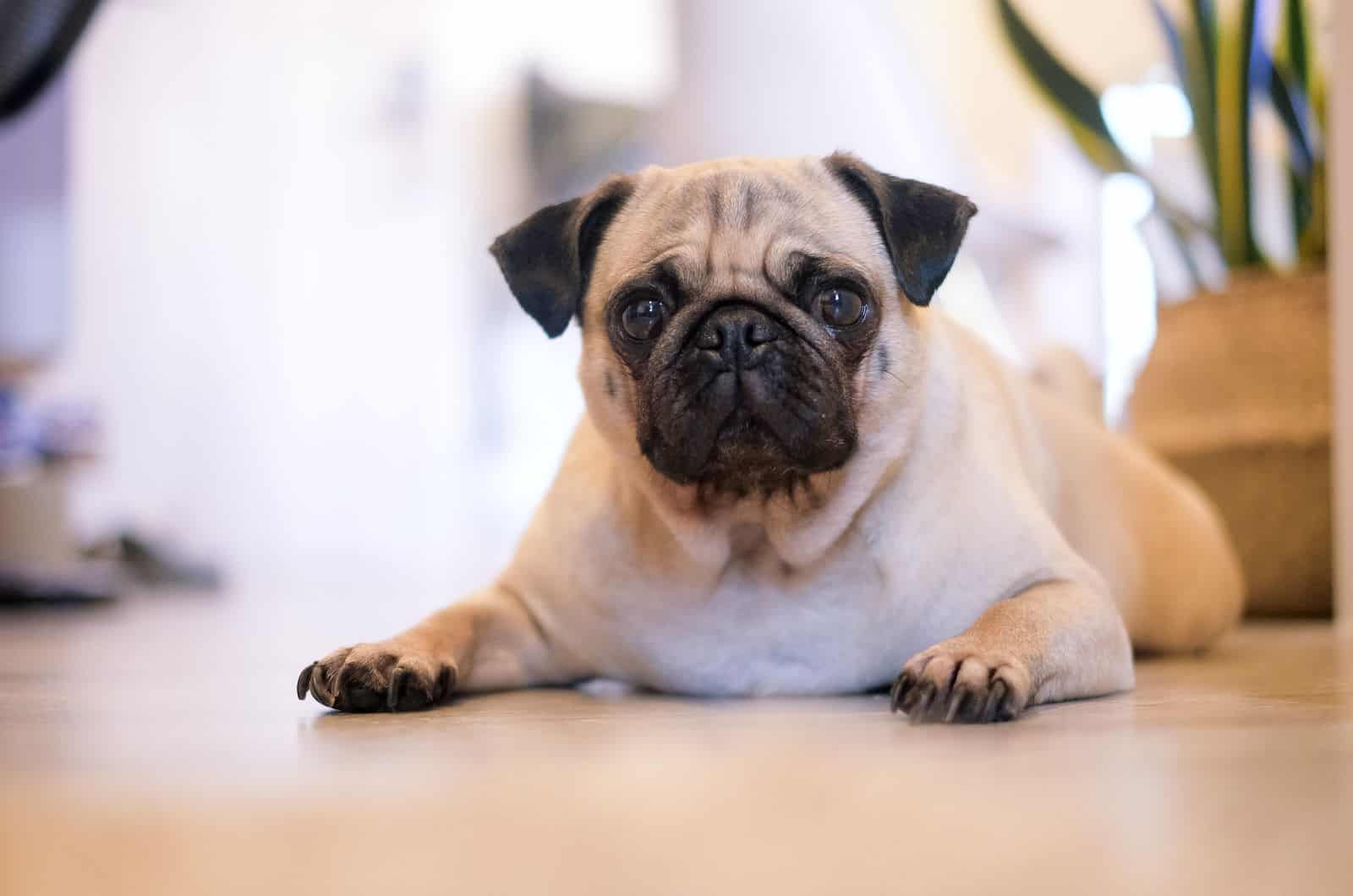
Pugs are ideal family dogs, even for those who aren’t very active. They don’t take up much room, and they only need about an hour of daily exercise.
Playfulness is his middle name, and he’ll keep you entertained with his fun and games until it’s time for a snooze or a cuddle on the sofa because he’s a small dog with a big heart. He adores his family, loves kids, and pretty much gets along with everyone, including other dogs.
In terms of size, our Pug growth chart shows that Pugs measure between 10 and 13 inches at the shoulder, which is about half the size of the GSD! They weigh between 14 and 18 pounds, which is only a fraction of the weight of the German Shepherd.
Size isn’t the only difference between these two breeds. While the GSD has a definite working dog background, the Pug hasn’t really done an honest day’s work throughout its long history!
It is believed to have been first bred way back in ancient China, possibly as long as 2,000 years ago or more. This little dog was a favorite among emperors, and a constant, loyal companion of the imperial court. It’s believed that this tiny pooch is distantly related to the enormous Tibetan Mastiff!
Pugs come in two official colors: fawn and black. Their coats are short and smooth, and they don’t require much grooming.
But, where did its name come from? Nobody knows for sure, although one school of thought suggests that it comes from the Latin word, pugnus, meaning ‘clenched fist’, as this is what the dog’s head resembles!
The Pug doesn’t have the same credentials as the GSD when it comes to police work, search and rescue, or as a service dog for those with disabilities. But then, it doesn’t really need to have them. It’s fine just the way it is!
If they have a fault, it’s that they can be quite stubborn. You can usually get around this by training them early. Once you can get them to listen to a handful of basic commands, you shouldn’t have too many problems.
What Is A German Shepherd Pug Mix Called?
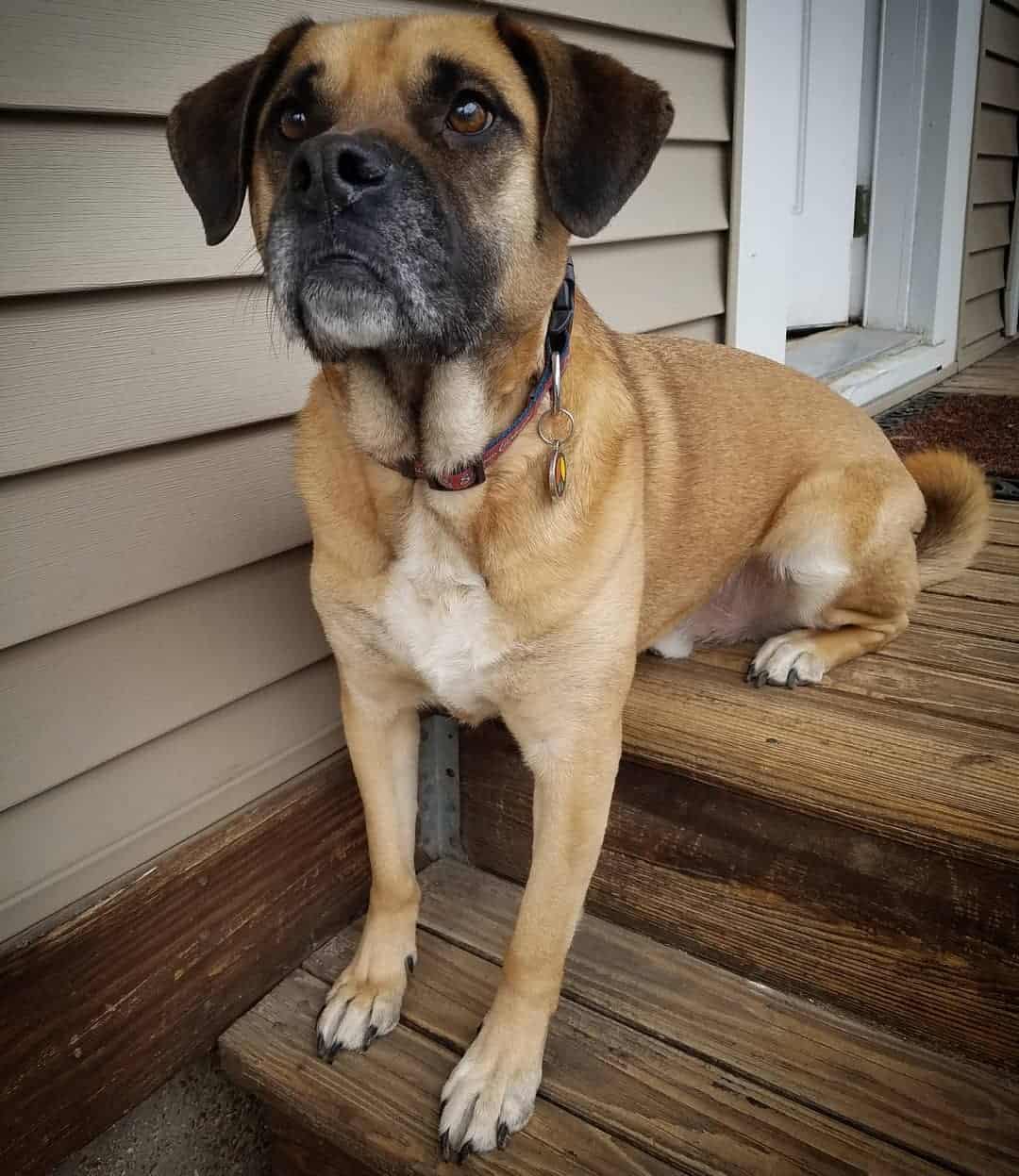
Photo from: @inked_recluse
In the time-honored tradition of naming hybrid dogs, some people have taken the two breed names and spliced them together, resulting in the Shug.
The problem is, another designer dog that’s a mix of the Shih-Tzu and the Pug is also called a Shug! However, some people call it the Pug-Zu.
To confuse the matter further, the German Shepherd Pug mix is also referred to as the Sheppug.
As you can see, there’s a real issue with designer dog names! In the end, people will call them what they want. As most kennel clubs don’t recognize these breeds because they are not purebred, there are no official names for any of these wonderful new hybrids.
As most people seem to use Shug when they’re talking about the German Shepherd Pug mix, we’ll go with the flow and use that here in this article.
Can A German Shepherd Mate With A Pug?
This is a good question, considering the size difference! This presents some logistical problems, to say the least. But, it can be done: with a bit of expert help, a male Pug can be bred with a female German Shepherd.
To do this the other way around, a female Pug and a male GSD, would be unsafe, risking the lives of the mother and her pups.
This is a good place to say a quick word about crossbreeding.
There are people who frown on designer dogs, crossbreeds, or hybrid dogs. Most of these people will be fans, breeders, or enthusiasts of traditional, purebred dogs. They believe that breeds should be preserved and kept pure. Breed standards are strictly enforced, and any dog that falls outside of these rules is banned from shows and excluded from breeding programs.
They also claim that crossbreeding causes health conditions, but this fails to take into account that years of inbreeding and selective breeding have resulted in most purebred dogs suffering from some serious health problems because of the restricted gene pool.
Those in favor of designer dogs point out that the fresh genes help to reduce the chances of these health conditions from being passed on, and the facts seem to be on their side so far.
Whichever side of the argument you are on, one thing is clear: dog breeding is not something to be taken lightly. It should be left to the experts, and never be undertaken by hobby-breeders or anyone without expert knowledge and experience.
These are precious lives that deserve respect, love, and care.
Speaking of unusual designer dogs, here are a few others you might want to check out:
• Corgi Rottweiler mix
• German Shepherd Doberman mix
• Great Dane German Shepherd mix
• Pitbull Husky mix
• Bernese Mountain Dog Poodle mix
• Jack Russell Beagle mix
• Labrador Retriever Pug mix
• Golden Retriever German Shepherd mix
• Border Collie Jack Russell mix
Some of these have to be seen to be believed, but they are all wonderful in their own unique ways.
What Does A Shug Look Like?
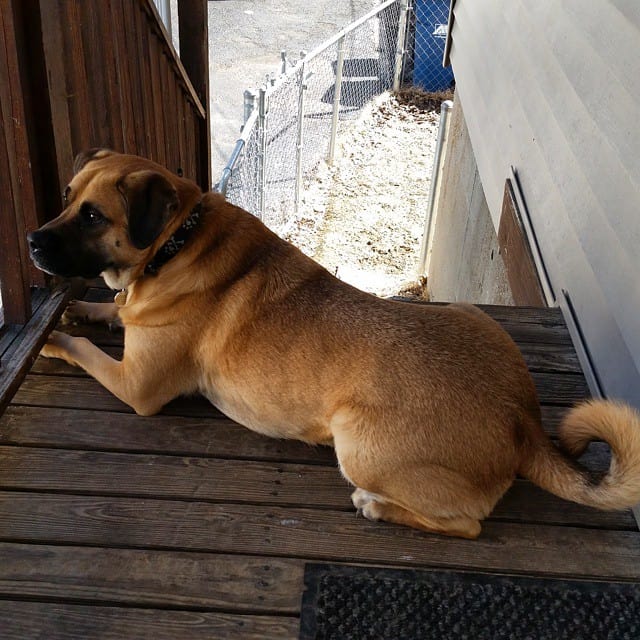
Photo from: @inked_recluse
The thing about mixed breed dogs is that they can be unpredictable in terms of their character and physical appearance. With the Shug, it all depends on whether the German Shepherd or the Pug parent genes are more prominent.
In terms of color, she will probably have the fawn coat of the Pug, although there are examples with the GSD’s classic black and tan. They can also be solid black, brindle, or silver fawn.
In most cases, they will have a black muzzle and a curly tail, which adds a real touch of cuteness. They often have floppy ears like the Pug, although sometimes, pups take after the GSD with erect ears.
Some have a longer snout, similar to the German Shepherd, while others have a more Pug-like snout, although it isn’t quite as flat. This is important when it comes to the Shug’s health issues, which we’ll deal with further along.
The German Shepherd Pug Mix Temperament
Both the GSD and the Pug are affectionate dogs, so be prepared for lots of love!
The Shug has the intelligence and loyalty of the GSD, and the playful mischievousness of the Pug. They are trusting, loving, and happy, and they’ll get along with everyone. Of course, this is assuming that they have been treated well.
Any dog that is mistreated can become distrustful and aggressive.
The Shug may show Pug-like stubbornness at times, which is why it’s important to train them at an early age.
There are two sides to the Shug that you’ll need to be aware of. First, they might bark at everything, which makes them good watchdogs. However, they’ll be more likely to fetch a toy for an intruder and ask them to play a game rather than leap to your defense!
Second, they hate being left alone for any length of time. Separation anxiety is a real problem for these little dogs because they just love you so much and don’t want to be parted from you.
If we were to add a third issue, it’s that because they adore you, they might become overprotective. While they are generally happy around other dogs and animals, there is a chance that they’ll warn them off if they suspect that you are in any danger (there might also be an element of jealousy involved!). To resolve this, you should ensure that your Shug puppy has proper socialization as soon as possible.
How Big Is A German Shepherd Pug Mix?
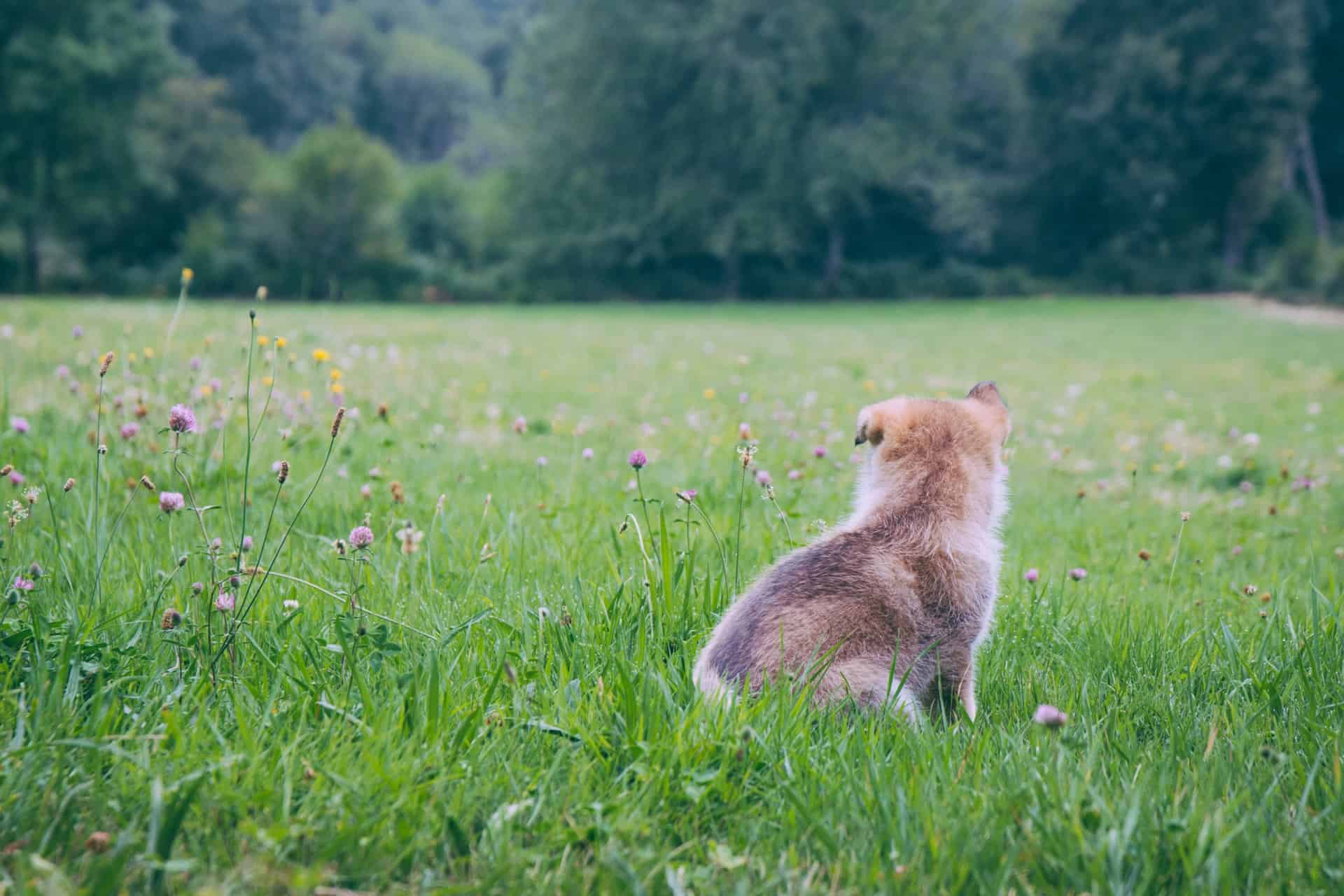
From what we’ve seen of this unusual little hybrid so far, your Shug dog will probably be slightly taller than the biggest Pug, but considerably smaller than the GSD. She’ll most likely be a medium-sized dog, around 15 inches in height, and weighing between 45 and 50 pounds.
For those who love the GSD but can’t handle their size (or who don’t have the space for one), the Shug is the ideal alternative.
This pint-sized pooch will fit in almost anywhere without too much trouble!
How Much Exercise Does A Shug Need?
As we’ve seen above, the Pug doesn’t even need a full hour, while the German Shepherd requires at least two!
What about the Shug?
Well, it depends on which parent it takes after. If it has a longer snout like the GSD, then it may be able to cope with between 30 and 45 minutes of daily exercise. If it has a flatter face, then you need to go easy, as your doggy friend will struggle to cope with too much exercise. Still, try to keep it around 30 minutes, but always watch them for signs of exhaustion or breathing difficulties. You can find more information about this in the section on health problems.
Neither the GSD nor the Pug can cope with extreme temperature, so you’ll need to avoid taking your Shug pup out when it’s too hot or too cold.
Any exercise should be a mixture between brisk walks and vigorous playtime, ideally broken into two or three sessions throughout the day. This should also include some kind of mental stimulation to keep their brain active and occupied.
Does A Shug Need Much Grooming?
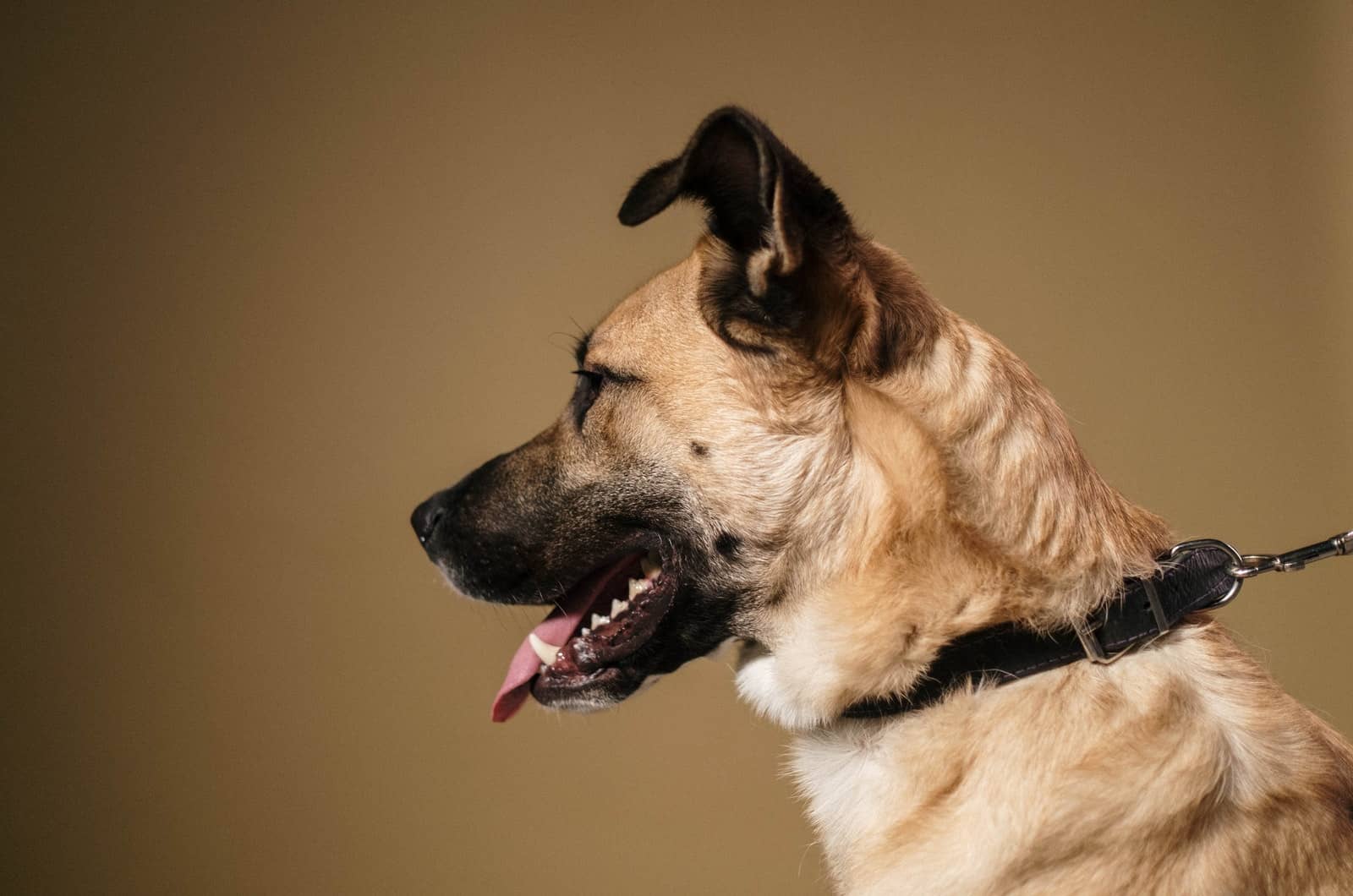
A regular grooming routine is an essential part of looking after any dog. The amount of work involved depends on the size of the dog and the length of its coat.
The German Shepherd Pug mix usually has a short, smooth coat that doesn’t need a lot of brushing. You can probably get away with two or three quick brushes a week; however, your furry friend would probably appreciate it if you brush her more often because she will love the attention!
While you’re at it, check her ears and eyes, and wipe away any dirt and debris that could cause infections. You should always brush her teeth daily if possible. This will give her lovely fresh breath, but more importantly, it will reduce the risk of serious tooth and gum infections; some of which can prove fatal.
You should always clip her toenails every few weeks, especially if your dog doesn’t go out on rough surfaces that will grind them down naturally. Understandably, some dog owners are worried that they’ll clip too far and hurt their precious pooch. To get around this, you could invest in a special set of clippers that has an in-built guard that only allows you to clip a tiny amount at a time. Alternatively, you can always get professional groomer to do the job for you!
There’s no need to bathe these dogs too frequently, as their short hair tends to stay pretty clean. Once every few months should suffice, and obviously, if they decide to explore muddy puddles.
Finally, these dogs aren’t regarded as hypoallergenic, which might be bad news for allergy sufferers. However, they are minimal shedders (even though both parent breeds shed quite a lot!) so it might not be too bad. If possible, try to spend time with one before you get yours to see if you are affected.
How Much Is A German Shepherd Pug Mix?
Dog prices are often difficult to pin down, as they are affected by so many factors.
If you’re lucky enough to live in the southern half of the USA, you’ll find that prices are generally much lower than in the north. This is mainly because there is a greater concentration of dog breeders in the south, and competition pushes down prices.
Then, there’s the fact that the German Shepherd Pug mix is a new breed. This means that breeders can really charge what they like, as there is nothing to compare it with. Some will advertise them as rare breeds, using this as justification for charging extortionate prices.
You also need to take into account the sex of the dog, as females may cost more because of their breeding potential.
The breeder’s reputation and experience will have a bearing on the price, too. You will also pay more for dogs that have been vaccinated and that have health certificates.
These are a few of the considerations that you need to keep in mind when buying a dog.
On the whole, you should generally expect to pay between $500 and $2,000 for your German Shepherd Pug mix.
That’s quite a wide margin!
What you need to remember is that many of these breeders will be using purebred dogs with impressive pedigrees. If you are happy with a $500 Shug, and the breeder checks out okay, then all is well.
Paying a high price does not necessarily guarantee that your Shug puppy will be 100% healthy, but don’t be swayed too much by low prices, as this can be a sign that someone is eager to sell a pup because it is weak and sickly.
Before buying, always research the breeder. Check their facility, and ask to see the pup and both parent dogs. Ask lots of questions, and be prepared to answer some. Reputable breeders love to chat about their work, which is a labor of love to them.
Avoid any that are reluctant to discuss details, give you a tour of the premises, or refuse to issue a health certificate. Needless to say, if they appear to be puppy mills, then run away very fast.
One final note on the cost of a German Shepherd Pug mix: the financial burden doesn’t end when you buy your dog. In fact, it has just begun. This cute little bundle of fur is going to cost you around $40 a month in dog food. If you want your pooch to be healthy, then you should only buy high-quality food; not any cheap, old stuff that’s packed with fillers.
As well as this, there will be vet bills for routine checks, and possibly for unforeseen medical emergencies (hopefully not, but it’s best to be prepared!).
German Shepherd Pug Mix Puppies
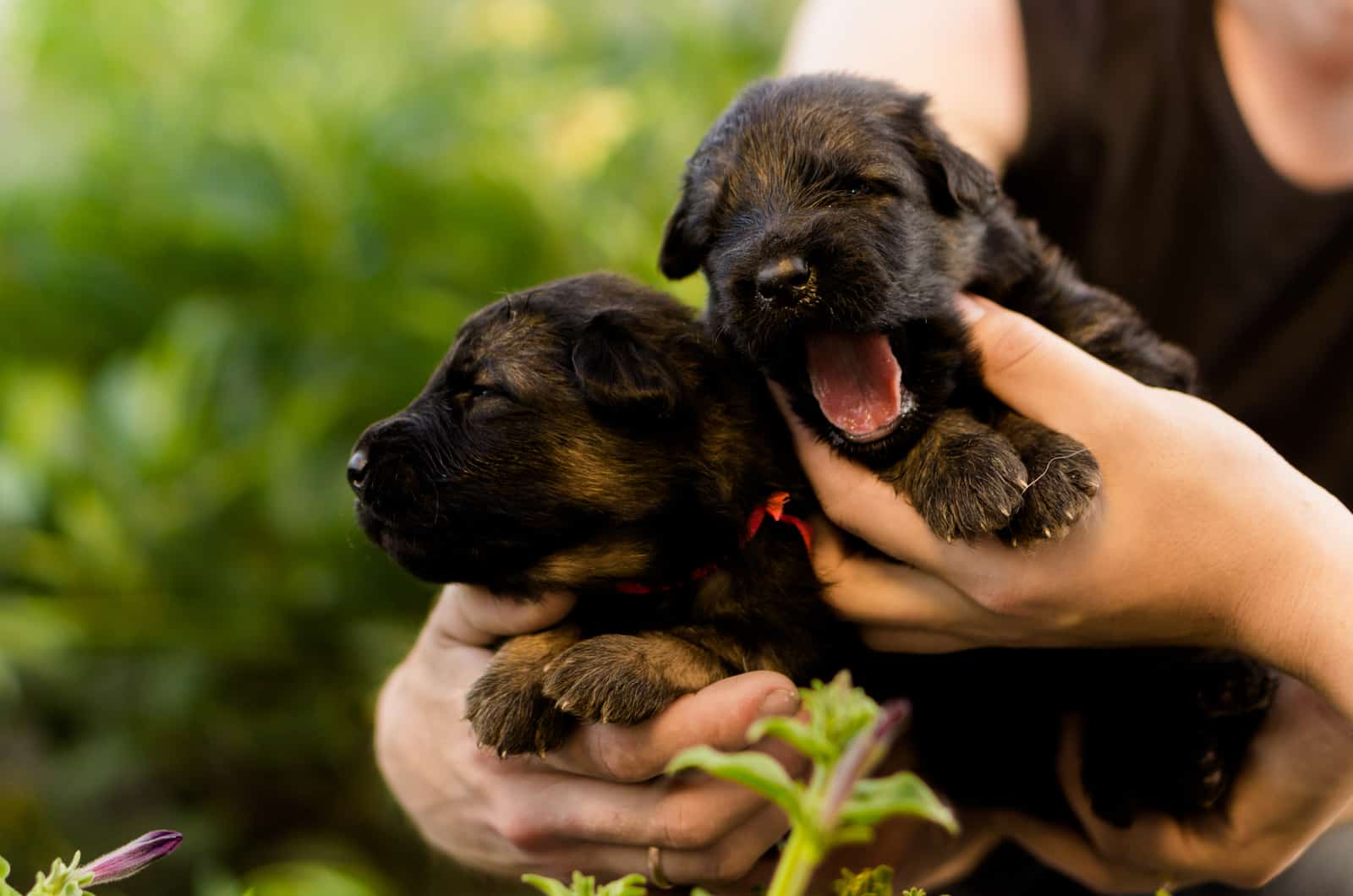
They’re ridiculously cute and even more ridiculously affectionate!
Seriously, this pup will melt your heart the moment you lay eyes on her. She will love you from the moment you pick her up. And, she is going to need a lot of love and care in return.
Following on from the section above where we mentioned finances, you’ll need to splash out a fair bit of cash to make sure you are ready to welcome your pup home. You’ll need bowls for food and water, a leash and collar, lots of toys, and a doggy bed, to name a handful of necessary items.
You should also consider investing in a good-quality dog crate, as this will be great for potty training. Pugs are notoriously slow at getting the hang of this, and the Shug may mirror this trait. If so, containing them in the crate while they learn the ropes will help to minimize accidents. It also gives the pup a safe space for sleeping, away from the areas where she plays.
Because of their acute separation anxiety, it might be necessary for you to move the crate close to your bed or you’ll be in for a lot of disturbed nights! Make sure that your pup goes to the potty last thing before sleeping, as this will help to reduce the chances of being disturbed.
Be patient while she is potty training. Harsh words and scolding will confuse her and set you back several days. She’ll get there soon enough!
Another task you should always consider is puppy-proofing. Take a look around your home and try to imagine it from a pup’s perspective… an energetic, fun-loving, mischievous, playful pup. A trailing electrical cable? Great for pulling on, and perhaps testing those tiny teeth that are giving so much hassle! A cabinet containing food or household cleaning products? Excellent for exploring, especially if the door opens easily.
What about coins, rubber bands, buttons, legos, etc. lying on the floor, or kicked under sofas and furniture? They’re all potential choking hazards. Remote controls, smartphones, shoes, you name it… there are a hundred items that can and will be chewed.
Mouthing is a natural process for pups, and chewing increases during the teething stages. Your pup will probably be going through its second teething stage when you get her, so you’ll need to direct her attention towards chew toys rather than anything you value in your home. But, chewing can become a habit, coupled with mouthing. Pups need to test their bite strength, and they’ll use anything, including your fingers, to do this. Again, you need to redirect her attention and be firm. Don’t shout, but let her know that this is not okay, and reward her when she gets it right.
Your pup will develop and grow soon enough. There will be tears and trials, but try to enjoy this time as much as you can because it will be over before you know it!
Do Shugs Have Many Health Problems?
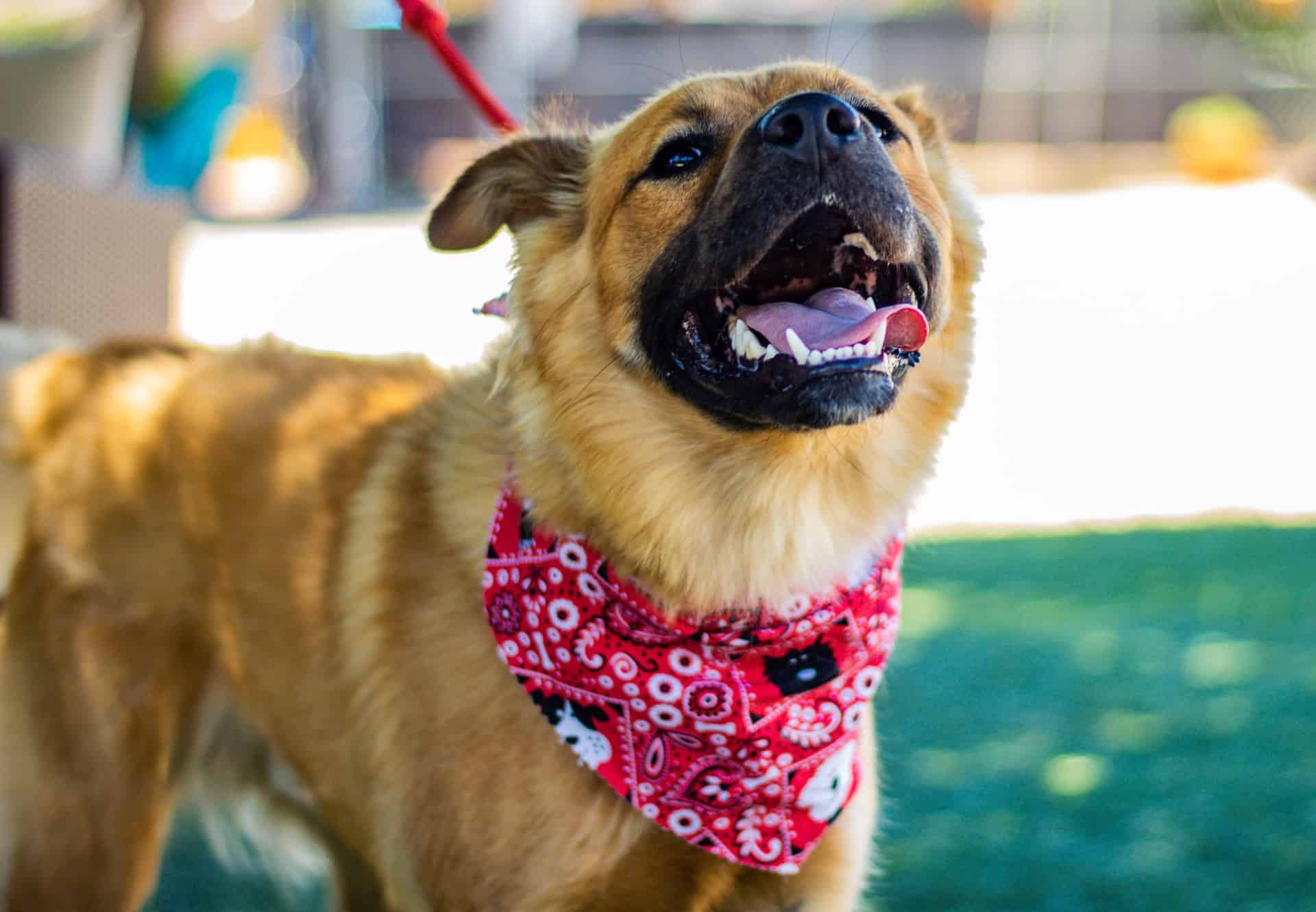
Sadly, all dogs are vulnerable to certain health conditions, although some breeds are much healthier than others.
The Pug is prone to quite a few health issues that can be passed on to its pups. Many of these stem from the fact that this is a brachycephalic breed. Brachycephalic dogs, such as the Pug, the French Bulldog, the Boxer, etc. all have short snouts and flat faces. This restricts the airways and causes them breathing difficulties, which can lead to collapse and even suffocation. This is known as Brachycephalic Obstructive Airway Syndrome (BOAS).
Because of this, it is wise to avoid taking these dogs into deep water, as they can easily drown. As well as struggling to breathe, the Pug’s little legs can’t work hard enough to propel them through the water.
If your Shug has a longer snout, like the GSD, then this shouldn’t be a problem. However, if she has a short, flat snout, then you need to take care.
Elbow and hip dysplasia are common problems in many dog breeds, including the parent breeds that make the Shug. Both problems are the result of joints that haven’t developed properly, causing bones to grind together painfully. In mild cases, a vet will prescribe anti-inflammatory drugs. However, in severe cases, the vet will recommend surgery.
The Pug is often plagued by several eye problems, such as entropion and ectropion, both connected with the eyelids either turning in or outward and causing hairs to scrape against the skin or the eyeball itself. This is painful and irritating, and it can lead to ulcers.
Large, deep-chested dogs are vulnerable to a condition called bloat, which has the medical name, Gastric Dilatation-Volvulus (GDV). Gases build up in the stomach and stop water or food from passing through. The stomach starts to twist on itself, cutting off blood supply to vital organs. This can be fatal if not diagnosed and treated quickly.
If your Shug is on the larger side and looks much like a GSD, then this is more of a risk.
There is a chance that your German Shepherd Pug mix might also suffer from allergies. Dogs can be allergic to pollen, dust mites, black mold, etc. However, most allergies are connected with proteins in food. Dogs don’t react the same way as humans. They sometimes sneeze and have runny noses, but more often than not, the reaction is seen on their skin, with dry, red, itchy patches. These are made worse when the dog scratches at it, breaking the skin, which makes it sore and raises the risk of infection.
Finally, we need to mention obesity. Small dogs are more at risk of obesity because of the way their metabolism works. You should never overfeed them, and meals should be split into two or three sessions. They should also get plenty of exercise to keep them fit and healthy.
Extra weight will put strain on their heart and joints, leading to serious health problems later in life such as diabetes, heart disease, and arthritis.
Overall, there’s no reason why your Shug shouldn’t be in good health. If you choose a good breeder, give your Shug proper care, and get them checked over by the vet once in a while, they’ll live a long and happy life!
Talking of which…
What Is The Lifespan Of A Shug?
Like most large breeds, the GSD has quite a short lifespan of between 7 and 10 years. On the other hand, the Pug has a life expectancy of between 13 and 15 years.
The Shug benefits from the Pug’s genes in this area, usually living between 12 and 15 years, maybe even longer.
This is curious, as the Pug, even though it has many more health concerns than the German Shepherd, tends to live longer. The Shug is likely to benefit from hybrid vigor; the scientific name for fresh genes that help to block certain health problems, avoiding many of those that plague the poor Pug parent, which is why there’s a good chance that Shugs will live good long lives!
Is This The Breed For You?
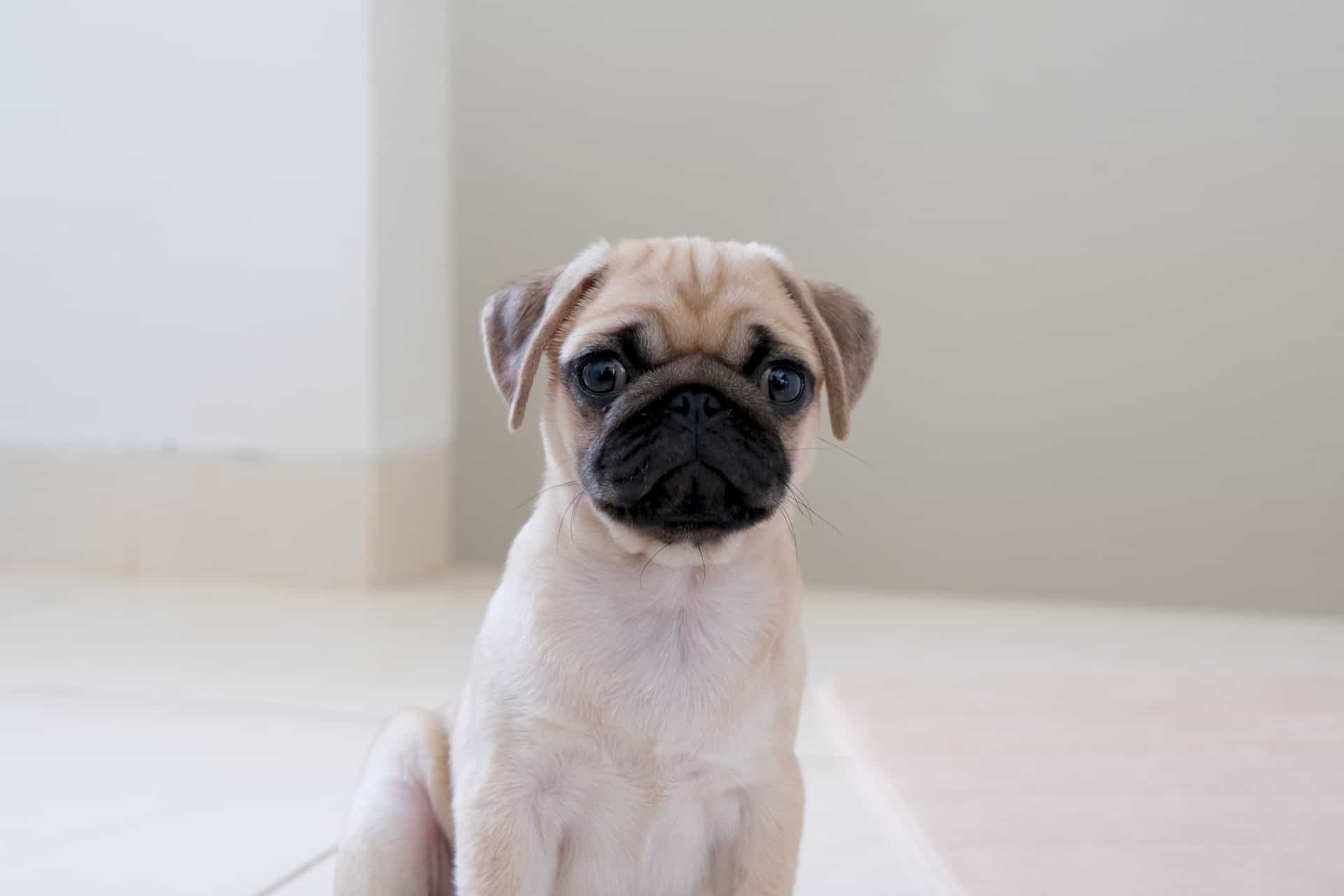
We’ve studied the German Shepherd Pug mix and learned quite a lot about this unusual little dog. So, what do you think? Is this a dog you’d be happy to have running around your home?
Is it the perfect designer dog?
Well, that’s a matter of opinion as there’s a lot of competition out there!
However, there’s no doubt that the Shug is one of the most affectionate dogs there is. He’ll adore you from the start, and will never want to be parted from you. This can be a problem if your lifestyle takes you out of the home for long periods and you can’t take your pooch with you.
He can’t be left tied up in a yard, and he won’t be happy shut away indoors for hours on end. Expect to find devastation in your home if you do this! And, the GSD part of him will mean that your lawn and flowerbeds might take a beating if you don’t keep him mentally stimulated.
Training shouldn’t be a problem, especially if the German Shepherd genes shine through. The Pug’s stubbornness might make it interesting, but with a bit of patience, you’ll soon have him properly trained. If you are a fan of Pugs, check also some other Pug mixes we listed!
In terms of health, your Shug will definitely fare better if he has the longer GSD snout. If he has a flat Pug face, then you’ll need to take extra care because of breathing difficulties.
He won’t take a lot of grooming, but you should brush him regularly to get rid of loose hairs, and he’ll love this bonding time anyway.
Make sure you give him a couple of brisk walks each day, along with some quality playtime. If you have kids, all the better! He’ll be in his element joining in the fun, or, more accurately, at the heart of it.
He’s cute, loyal, mischievous, fun, affectionate, and sometimes a bit loud. His GSD side may make him act coolly towards strangers to begin with, but with early socialization, he’ll learn to accept them and they’ll soon be firm friends.
In the end, it doesn’t matter whether he’s the perfect designer dog. All you need to ask yourself is whether he’s the best dog for you.
Read Next: Are Pugs Aggressive? (5 Reasons, Signs, And Prevention)
